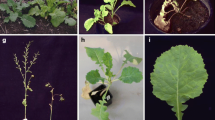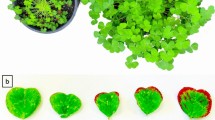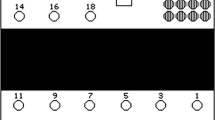Abstract
Aphid-transmitted virus diseases are a constraint on production of faba bean (Vicia faba) and other cool season grain legumes in northern New South Wales (NSW), Australia. A field study in 2004 identified potentially important aphid vectors of viruses that infect faba bean. Individual alatae were trapped on vertical nets in four field situations and placed immediately on bioassay plants (faba bean seedlings) to identify viruses transmitted in persistent and non-persistent manners. Viruses were identified by nine virus-specific tissue blot immunoassays (TBIAs). Out of a total of 447 individual alatae comprising 14 species, 10 individuals comprising three aphid species transmitted a virus: five Acyrthosiphon pisum (two that transmitted Bean leafroll virus, two Bean yellow mosaic virus, and one Soybean dwarf virus, SbDV), four Aphis craccivora (all Beet western yellows virus, BWYV), and one Myzus persicae (BWYV). No transmissions were detected for the other 11 aphid species, including the faba bean colonising species Acyrthosiphon kondoi, although virus-like symptoms were observed in some cases. None of the alatae transmitted Subterranean clover stunt virus, Alfalfa mosaic virus, Cucumber mosaic virus, Pea seed-borne mosaic virus, or Turnip mosaic virus. In separate tests in which acquisition fed apterae were used to inoculate faba bean, A. pisum was able to transmit four additional isolates of SbDV from chickpea or subterranean clover from Queensland, Tasmania, and NSW. The potential importance of A. pisum, A. craccivora, and M. persicae as vectors is discussed. Of these, A. pisum appears the most likely to cause crop losses in faba bean based on propensity as a vector, numbers trapped, efficient colonisation, and severity of virus isolates transmitted.
Similar content being viewed by others
References
Abraham AD, Menzel W, Lesemann DE, Varrelmann M, Vetten HJ (2006) Chickpea chlorotic stunt virus: A new polerovirus infecting cool-season food legumes in Ethiopia. Phytopathology 96, 437–446. doi: 10.1094/PHYTO-96-0437
Abraham AD, Menzel W, Vetten HJ, Saucke H (2007) First report of Soybean dwarf virus (genus Luteovirus) infecting faba bean and clover in Germany. Plant Disease 91, 1059. doi: 10.1094/PDIS-91-8-1059B
Anonymous (1944) Diseases of broad beans. The Agricultural Gazette of New South Wales 55, 426-429.
Anonymous (2009) Australian Plant Pest Database. Website administered by the Department of Agriculture, Fisheries and Forestry, Canberra, Australia. http://www.planthealthaustralia.com.au/our_projects/display_project.asp?category=4&ID=1. Last access 7 Feb. 2009.
Ashby JW (1980) Virus diseases of annual legume crops. Proceedings of the Agronomy Society of New Zealand 10, 77–80.
Australian Bureau of Agricultural and Research Economics (2007) Australian area sown, yield and production of selected pulses by state. In ‘Australian Commodity Statistics 2007’. pp. 194–196. (ABARE: Canberra, Australia)
Berlandier FA, Thackray DJ, Jones RAC, Latham LJ, Cartwright L (1997) Determining the relative roles of different aphid species as vectors of cucumber mosaic and bean yellow mosaic viruses in lupins. Annals of Applied Biology 131, 297–314.doi:10.1111/j.1744-7348.1997.tb05158.x
Blackman RL, Eastop VF (2000) ‘Aphids on the world’s crops: an identification and information guide. 2nd edition.’ 466 pp. (John Wiley & Sons: Chichester, UK)
Cammell ME, Way MJ (1983) Aphid pests. In ‘The faba bean (Vicia faba L.)’. (Ed. PD Hebblethwaite) pp. 315–346. (Butterworths: London)
Chan CK, Forbes AR, Raworth DA (1991) ‘Aphid-transmitted viruses and their vectors of the world. Technical Bulletin 1991-3E.’ (Minister of Supply and Services Canada)
Cockbain AJ (1983) Viruses and virus-like diseases of Vicia faba L. In ‘The faba bean (Vicia faba L.)’. (Ed. PD Hebblethwaite) pp. 421–462. (Butterworths: London)
D’Arcy CJ, Domier LL (2005) Family Luteoviridae. In ‘Virus taxonomy. Classification and nomenclature of viruses. Eighth report of the International Committee on the Taxonomy of Viruses’. (Eds CM Fauquet, MA Mayo, J Maniloff, U Desselberger, LA Ball) pp. 891–900. (Elsevier Academic Press: London)
Duffus JE (1964) Host relationships of beet western yellows virus. Phytopathology 54, 736–738.
Edwards OR (2001) Interspecific and intraspecific variation in the performance of three pest aphid species on five grain legume hosts. Entomologia Experimentalis et Applicata 100, 21–30. doi: 10.1023/A:1019202917690
Fletcher MJ (1978) Key to aphids (Homoptera: Aphididae) found on leguminous plants in Australia. Australian Entomological Magazine 4, 91–94.
Fraser L, Conroy RJ (1963) Vascular wilt disease of broad beans and other plants. The Agricultural Gazette of New South Wales 74, 225–229.
Gildow FE, Damsteegt VD, Stone AL, Smith OP, Gray SM (2000) Virusvector cell interactions regulating transmission specificity of soybean dwarf luteoviruses. Journal of Phytopathology-Phytopathologische Zeitschrift 148, 333–342. doi: 10.1046/j.1439-0434.2000.00518.x
Graichen K, Rabenstein F (1996) European isolates of beet western yellows virus (BWYV) from oilseed rape (Brassica napus L. ssp. napus) are non-pathogenic on sugar beet (Beta vulgaris L. var. altissima but represent isolates of turnip yellows virus (TuYV). Zeitschrift fur Pflanzenkrankheiten und Pflanzenschutz 103, 233–245.
Grylls NE (1972) Aphid infestation and virus infection of peas and beans on the Central Tablelands of New South Wales. Australian Journal of Experimental Agriculture and Animal Husbandry 12, 668–674. doi: 10.1071/EA9720668
Grylls NW, Peak JW (1969) A virus complex of subterranean clover. Australian Journal of Agricultural Research 20, 37–45. doi: 10.1071/AR9690037
Halbert SE, Mink GI, Silbernagel MJ, Mowry TM (1994) Transmission of bean common mosaic virus by cereal aphids (Homoptera: Aphididae). Plant Disease 78, 983–985.
Helms K, Waterhouse PM, Carver M (1983) Aulacorthum (Neomyzus) circumflexum, a vector of subterranean clover red leaf virus. Australasian Plant Pathology 12, 66–67. doi: 10.1071/APP9830066
Helms K, Muller WJ, Waterhouse PM (1993) National survey of viruses in pastures of subterranean clover. I. Incidence of four viruses assessed by ELISA. Australian Journal of Agricultural Research 44, 1837–1862. doi: 10.1071/AR9931837
Herrbach E (1999) Virus-vector interactions. In ‘The Luteoviridae’. Introduction. (Eds HG Smith, H Barker) pp. 85–88. (CABI Publishing: Wallingford, UK)
Irwin ME, Ruesink WG (1986) Vector intensity: a product of propensity and activity. In ‘Plant virus epidemics. Monitoring, modelling, and predicting outbreaks’. (Eds GD McLean, RG Garrett, WG Ruesink) pp. 13–33. (Academic Press, Sydney)
Jayasena KW, Randles JW (1984) Patterns of spread of the non-persistently transmitted bean yellow mosaic virus and the persistently transmitted subterranean clover red leaf virus in Vicia faba. Annals of Applied Biology 104, 249–260. doi: 10.1111/j.1744-7348.1984.tb05609.x
Johnstone GR (1978) Diseases of broad bean (Vicia faba L. major) and green pea (Pisum sativum L.) in Tasmania caused by subterranean clover red leaf virus. Australian Journal of Agricultural Research 29, 1003–1010. doi: 10.1071/AR9781003
Johnstone GR, Guy PL (1986) Epidemiology of viruses transmitted persistently by aphids. In ‘Proceedings of the Third International Workshop on Epidemiology of Plant Virus Diseases, Orlando, Florida, 6–8 August’. (Ed. OW Barnett) pp. IX/1-IX/7. (International Society of Plant Pathology)
Johnstone GR, Patten DS (1981) Sub-clover red leaf and sub clover stunt viruses are not transmitted by lucerne and pea aphids. Australasian Plant Pathology 10, 65–66. doi: 10.1071/APP9810065
Johnstone GR, Rapley PEL (1979) The effect of time of sowing on the incidence of subterranean clover red leaf virus infection in broad bean (Vicia faba). Annals of Applied Biology 91, 345–351. doi: 10.1111/j.1744-7348.1979.tb06511.x
Johnstone GR, Rapley PEL (1981) Control of subterranean clover red leaf virus in broad bean crops with aphicides. Annals of Applied Biology 99, 135–141. doi: 10.1111/j.1744-7348.1981.tb05140.x
Johnstone GR, Ashby JW, Gibbs AJ, Duffus JE, Thottapilly G, Fletcher JD (1984a) The host ranges, classification and identification of eight persistent aphid-transmitted viruses causing diseases in legumes. Netherlands Journal of Plant Pathology 90, 225–245. doi: 10.1007/BF01976381
Johnstone GR, Liu H-Y, Duffus JE (1984b) First report of a subterranean clover red leaf-like virus in the Western Hemisphere (Abstr.). Phytopathology 74, 795.
Kellock AW (1971) Red-leaf virus- a newly recognized virus disease of subterranean clover (Trifolium subterraneum L.). Australian Journal of Agricultural Research 22, 615–624. doi: 10.1071/AR9710615
Kumari SG, Makkouk KM (2007) Virus diseases of faba bean (Vicia faba L.) in Asia and Africa. Plant Viruses 1, 93–105.
Kumari SG, Rodoni B, Loh M, van Leur J, Freeman A (2008) Detection of DNA and RNA plant viruses from plant tissue prints on nitrocellulose membranes byPCR. Journal of Plant Pathology 90 (Suppl. 2), pp. S2.302. [Abstract]
Latham LJ, Jones RAC (2001) Incidence of virus infection in experimental plots, commercial crops, and seed stocks of cool season crop legumes. Australian Journal of Agricultural Research 52, 397–413. doi: 10.1071/AR00079
Lin NS, Hsu YH, Hsu HT (1990) Immunological detection of plant viruses and a mycoplasmalike organism by direct tissue blotting on nitrocellulose membranes. Phytopathology 80, 824–828. doi: 10.1094/Phyto-80-824
Makkouk KM, Damsteegt V, Johnstone GR, Katul L, Lesemann D-E, Kumari SG (1997) Identification and some properties of soybean dwarf luteovirus affecting lentil in Syria. Phytopathologia Mediterranea 36, 135–144.
Makkouk KM, Vetten HJ, Katul L, Franz A, Madkour MA (1998) Epidemiology and control of faba bean necrotic yellows virus. In ‘Plant virus disease control’. (Eds A Hadidi, RK Khetarpal, H Koganezawa) pp. 534–540. (APS Press: St. Paul, MN, USA)
Pirone TP, Harris KF (1977) Nonpersistent transmission of plant viruses by aphids. Annual Review of Phytopathology 15, 55–73. doi: 10.1146/annurev.py.15.090177.000415
Ridland PM, Berg GN (1981) Seedling resistance to pea aphid of lucerne, annual medic and clover species in Victoria. Australian Journal of Experimental Agriculture and Animal Husbandry 21, 506–511. doi: 10.1071/EA9810506
Schwinghamer M, Schilg M, Moore K, Kumari S, Srivastava M, Wratten K, Knights E, Bambach R, Southwell R (2003) The virus situation in chickpea, faba bean, and canola. In ‘Update of research in progress at the Tamworth Agricultural Institute 2002. Agdex 100/005’. (Ed. R Martin) pp. 44–47. (NSW Agriculture, Tamworth, NSW, Australia)
Schwinghamer MW, Johnstone GR, Johnston-Lord CF (1999) First records of bean leafroll luteovirus in Australia. Australasian Plant Pathology 28, 260. doi: 10.1071/AP99042
Schwinghamer MW, Thomas JE, Parry JN, Schilg MA, Dann EK (2007) First record of natural infection of chickpea by Turnip mosaic virus. Australasian Plant Disease Notes 2, 41–43. doi: 10.1071/DN07020
Smith PR (1966) Adisease of French beans (Phaseolus vulgaris L.) caused by subterranean clover stunt virus. Australian Journal of Agricultural Research 17, 875–883. doi: 10.1071/AR9660875
Srithongchai W (1990) Virus diseases of Trifolium subterraneum and Vicia faba in Tasmania. Ph.D. Thesis, University of Tasmania, Hobart, Tasmania, Australia.
Stubbs LL (1947) A destructive vascular wilt virus disease of broad bean (Vicia faba L.) in Victoria. The Journal of Agriculture, Victoria July, 323–332.
Tamada T, Kojima M (1977) ‘Soybean dwarf virus. AAB Descriptions of plant viruses. No. 179.’ (Association of Applied Biologists, Wellesbourne, UK) http://www.dpvweb.net/dpv/showadpv.php?dpvno=179. Last access 11 Feb. 2009.
Terauchi H, Honda K-i, Yamagishi N, Kanematsu S, Ishiguro K, Hidaka S (2003) The N-terminal region of the readthrough domain Is closely related to aphid vector specificity of Soybean dwarf virus. Phytopathology 93, 1560–1564. doi: 10.1094/PHYTO.2003.93.12.1560
van Leur J, Kumari S, Freeman A (2004) Faba bean surveys during 2003 and the occurrence and peculiarities of Subterranean clover stunt virus, a potentially serious disease. In ‘Update of research in progress at the Tamworth Agricultural Institute 2004. Agdex 100/005’. (Ed. R Martin) pp. 43–45. (NSW Department of Primary Industries, Tamworth, NSW, Australia)
Wilson J, Close RC (1973) Subterranean clover red leaf virus and other legume viruses in Canterbury. New Zealand Journal of Agricultural Research 16, 305–310.
Yamagishi N, Terauchi H, Honda K-i, Kanematsu S, Hidaka S (2006) Discrimination of four soybean dwarf virus strains by dot-blot hybridization with specific probes. Journal of Virological Methods 133, 219–222. doi: 10.1016/j.jviromet.2005.10.028
Author information
Authors and Affiliations
Corresponding author
Rights and permissions
About this article
Cite this article
Schwinghamer, M.W., Nicholas, A.H. & Schilg, M.A. Three aphid vectors of faba bean (Vicia faba) viruses in northern New South Wales and occurrence of Acyrthosiphon pisum-transmitted isolates of Soybean dwarf virus . Australasian Plant Pathology 38, 262–269 (2009). https://doi.org/10.1071/AP09001
Received:
Accepted:
Issue Date:
DOI: https://doi.org/10.1071/AP09001




